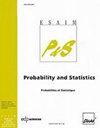用质心Voronoi镶嵌的Blaschke-Santalo图的数值逼近
IF 0.7
4区 数学
Q4 STATISTICS & PROBABILITY
引用次数: 0
摘要
识别Blaschke-Santal图是一个重要的主题,本质上包括确定映射$F:X\到{\mathbb{R}}^d$的图像$Y=F(X)$,其中源空间$X$的维数远大于目标空间的维数。在某些情况下,例如在形状优化问题中,X甚至可以是无限维空间的一个子集。通常的蒙特卡罗方法,包括在$X$中随机选择$x_1,\dots,x_N$的个数$N$,并将它们绘制在目标空间${\mathbb{R}}^d$中,在许多情况下,在$Y$中产生非常高和非常低的集中区域,从而导致对图像集的相当粗糙的数值识别。相反,我们的目标是以适当的方式选择点$x_i$,从而在目标空间中产生均匀分布。通过这种方式,我们可以通过相对较少的N个样本获得图像集Y的良好表示,这在源空间X很大(甚至无限)并且F(x_i)$的求值很昂贵时非常有用。我们的方法包括适当地使用{\it质心Voronoi镶嵌},它提供了有效的数值结果。文中给出了二维和三维实例的仿真。本文章由计算机程序翻译,如有差异,请以英文原文为准。
On the numerical approximation of Blaschke-Santalo diagrams using Centroidal Voronoi Tessellations
Identifying Blaschke-Santal\'o diagrams is an important topic that essentially consists in determining the image $Y=F(X)$ of a map $F:X\to{\mathbb{R}}^d$, where the dimension of the source space $X$ is much larger than the one of the target space. In some cases, that occur for instance in shape optimization problems, $X$ can even be a subset of an infinite-dimensional space. The usual Monte Carlo method, consisting in randomly choosing a number $N$ of points $x_1,\dots,x_N$ in $X$ and plotting them in the target space ${\mathbb{R}}^d$, produces in many cases areas in $Y$ of very high and very low concentration leading to a rather rough numerical identification of the image set. On the contrary, our goal is to choose the points $x_i$ in an appropriate way that produces a uniform distribution in the target space. In this way we may obtain a good representation of the image set $Y$ by a relatively small number $N$ of samples which is very useful when the dimension of the source space $X$ is large (or even infinite) and the evaluation of $F(x_i)$ is costly. Our method consists in a suitable use of {\it Centroidal Voronoi Tessellations} which provides efficient numerical results. Simulations for two and three dimensional examples are shown in the paper.
求助全文
通过发布文献求助,成功后即可免费获取论文全文。
去求助
来源期刊

Esaim-Probability and Statistics
STATISTICS & PROBABILITY-
CiteScore
1.00
自引率
0.00%
发文量
14
审稿时长
>12 weeks
期刊介绍:
The journal publishes original research and survey papers in the area of Probability and Statistics. It covers theoretical and practical aspects, in any field of these domains.
Of particular interest are methodological developments with application in other scientific areas, for example Biology and Genetics, Information Theory, Finance, Bioinformatics, Random structures and Random graphs, Econometrics, Physics.
Long papers are very welcome.
Indeed, we intend to develop the journal in the direction of applications and to open it to various fields where random mathematical modelling is important. In particular we will call (survey) papers in these areas, in order to make the random community aware of important problems of both theoretical and practical interest. We all know that many recent fascinating developments in Probability and Statistics are coming from "the outside" and we think that ESAIM: P&S should be a good entry point for such exchanges. Of course this does not mean that the journal will be only devoted to practical aspects.
 求助内容:
求助内容: 应助结果提醒方式:
应助结果提醒方式:


